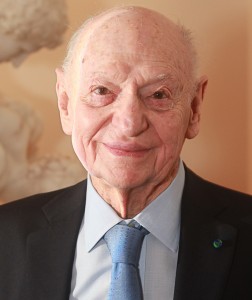Alexander Margulis Reflects on Global – and Local – Accomplishments
Alexander Margulis, MD, who served as professor and chair of the Department of Radiology & Biomedical Imaging from 1963 to 1989, was recently appointed to the rank of Chevalier of the French Legion of Honor by the President of France for educating most of the present leaders of French radiology during his years at UCSF. The Margulis Society was named for Dr. Margulis, in recognition of his many years of leadership and innovation at UCSF. His reflections on the award, and on UCSF and radiology during his tenure here, follow.
When I was chairman at UCSF, one of my goals was to help UCSF disseminate excellence in radiology throughout the world. To do that, I focused on the three areas. First, I aimed to have the highest quality of practice, because in medicine, it is impossible to teach what you cannot apply. Second, I aimed to bring people from all over the world to learn, so they could improve the care of patients worldwide. Finally, I aimed to ensure that we continued to advance the field through research. We had a superb faculty supported by a solid infrastructure, so talented scientists wanted to come and do research. We expected they would help to advance the field and advance their careers, and would then return to become heads of departments in various institutions around the world.
I was lucky, and I had a number of very good friends who were leaders of French radiological education. They were professors at the various branches of French Universities who sent me the brightest people to do research. Thanks to these friends and my other international connections, UCSF radiology became a center for international education, and we probably trained almost every important professor of radiology in France, Germany, Sweden, Japan and China. They were all young people who came with funding from their own countries and spent six months to a year doing research. It was a very productive environment, and UCSF was recognized as the leader for radiology training in the world.
During my tenure at UCSF, I was also fortunate to have recruited several very important basic scientists, and UCSF was one of just two places – the other was in London – that developed MRI as a clinical specialty. I even gave the new imaging method its current name. Previously, it was called NMR -- nuclear magnetic resonance.
My predecessor at UCSF, Robert Stone, was the medical officer of the Manhattan project team during World War II and was well-placed to direct research funding from the Atomic Energy Commission (AEC) to our campus after the war. The AEC granted him funds to build a cyclotron at UCSF to treat cancer. When I became head of radiology at UCSF I wrote to the AEC for help in starting a national lab of radiobiology at UCSF. So, in the late 1960s, the building that used to be the lab of the cyclotron was beautifully transformed into the radiobiology lab, and UCSF founded a new area of medicine – radiobiology.
During the ‘70s and ‘80s there were other dramatic developments that shaped the field we enjoy today. While UCSF did not develop CT, several of our physicists made noteworthy improvements in the speed of CT and our chief of physics, Leon Kaufman, was the person who truly turned MRI around.
UCSF also became well known for the team that made ultrasound, particularly obstetric ultrasound, a very important subspecialty. The leader of that team, Roy Filly, was probably the most important person in ultrasound in the United States.
Another one of my contributions to UCSF was helping to create a second campus. I came up with the idea because many departments were constrained for space on Parnassus Heights. After I stepped down as Chair of Radiology, the chancellor, Julius Krevans, to whom I sold the idea (it was not difficult to sell), made me associate chancellor, and I was tasked with making it possible to get a second campus.
A huge Taiwanese company promised me they would donate money so UCSF could buy 100 acres of land in Brisbane. However, the mayor of San Francisco, Willie Brown, didn’t want to have UCSF in Brisbane, so he worked out a deal with the owners of land in the area around China Basin. If the company that owned the land were to donate space for the UCSF campus, the mayor would see that they got permits to build housing, and that’s how we got the land for the campus we now call Mission Bay.
My time in San Francisco was one of the most glorious parts of my life. I moved to New York because my wife, Hedvig Hricak, an eminent radiologist whose work is focused on cancer, became head of radiology at Memorial Sloan Kettering Cancer Center. In 2000, I became a Clinical Professor of Radiology at Weill Cornell Medical College of Cornell University in New York City. I enjoyed my time at Cornell, and receiving the teaching award in 2013 was special. However, UCSF has always remained the most precious to me.
While my decoration as a Chevalier of the French Legion of Honor is very meaningful for me personally, it also reflects the wonderful accomplishments of our great department at UCSF, as well.

